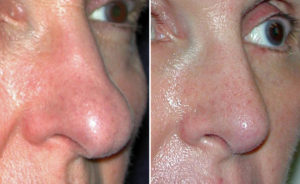
In addition to the change in the appearance of the nose with age, breathing through the nose can also become more difficult. As the tip of the nose drops downward, the nostrils become more blocked and the important internal nasal valves inside the nose close down. This may make for a nasal breathing problem that one didn’t used to have.
Why would an older patient want a rhinoplasty? Isn’t rhinoplasty a young person’s operation? While rhinoplasty is by far more commonly performed under the age of 40, these are older people who want to change their nose. In the older patient, the most common reasons are to shorten a long nose (so as to not look older) and to improve their breathing. While some have concerns about the motivations and desires of the older rhinoplasty patient, I have found them to be easier to please than most younger patients.
The main objective in the older rhinoplasty patient is to change the tip of the nose, lifting and refining it. In lifting up and refining the tip of the nose, the overall nose become shorter. It is usually not necessary to break the bones of the nose in the older rhinoplasty as the bridge does not usually need to be lowered to any significant degree. Standard rhinoplasty techniques are used, including the benefits of the open approach by lifting up the skin of the nose so one can see and shape the tip of the nose more accurately. When the tip of the nose comes up, the nostrils are opened more and breathing is usually improved.
Dr. Barry Eppley
Indianapolis, Indiana


